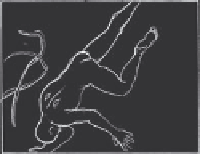Graphics Reference
In-Depth Information
character have to be separated onto their individual tracks. Secondly, the atmospheres for all the various
scenes have to be added, each location requires different environments. This gives the show 'life' but it's
the third element that brings me into Rupert's world - the footsteps. These provide the base element for
the fi nal layer, the sound effects. These combine many layers to create believable environments.
The most challenging element is making a show unique. Sound design plays a large part. Most of the day
is spent coming up with new sounds to involve the viewer in Rupert's world. Edward runs in a fi eld, up
the steps of the tree house, through the front door and stopping inside. I track lay grass footsteps, heavy
wooden footsteps, a door closing and lighter wooden footsteps. With some dialogue extras of Edward
running a simple scene becomes complex. Detail in the sound, however small, is always key to a good
show, whether it's the brushing of clothes or a pencil writing. Sound is crucial to create the illusion that
involves the audience.
Children have to believe what they are watching is real to the point they could almost interact with the
characters. The sound track helps bring the audience, especially children, into the animated world.
Music
Music, needing a whole topic to itself (along with sound), is an underrated element, too often
added as an afterthought. It's potentially up there with the visuals, and as integrated. Music
added after shooting can make life easier on the set, but tougher for the composers trying to
merge haphazard rhythms into a unii ed whole. I prefer working with music from the start, so
that the animation can rel ect the music, following the pacing and bring a great discipline. This
depends on the function of the music, whether it is background underscoring or a part of the
storytelling, as in my i lms of
Rigoletto
and
Gilbert and Sullivan
. It would have been impossible
to have laid a score down afterwards for these, and the score adaptations were done as part of
the storyboarding. Working with the musical director, Wyn Davies, we made sure that Verdi's
and Sullivan's music l owed dramatically and was respected.
I've said that stop motion is like dance in its celebration of movement and rhythm, and music
should be encouraged to be as important as a score for a ballet. One of the most beautiful
marriages has to be Michael Dudok de Wit's exquisite
The Monk and the Fish
, set to music by
Corelli. It is hard to imagine one without the other. The music adds joy and life, and makes the
i lm l ow. Usually a classical orchestral sound needs a suitable richness from the visuals to work
(there have been some spectacular duds with orchestras rampaging away to animation that
would make Saturday morning fodder blush: Tchaikovsky seems particularly abused), but here
the drawings are simple and the music is appropriate.
Nigel Hess' beautiful and apt scores to
Screen Play
and
Achilles
were both, unusually, written to
the i nished score. Rather than illustrating the scene they are a major part of the story
telling, uniting all the elements in an integrated whole. It's a privilege to have such
scores.
I would suggest that being able to read music is essential as a score is not very
dif erent from our own bar sheets, turning sound and music into a very visual
shape full of helpful patterns. On
Rigoletto
, the score became my storyboard and
bar sheet all in one.



Search WWH ::

Custom Search